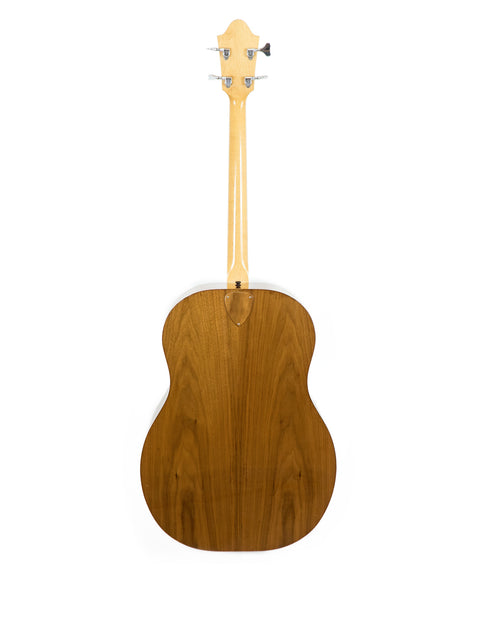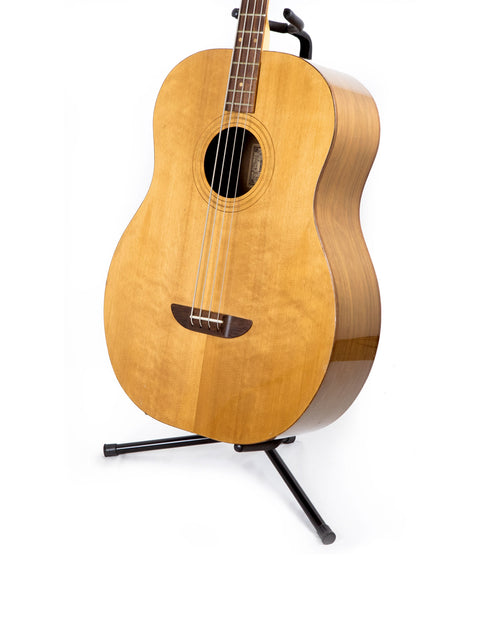Earthwood












SOLD - Ernie Ball Earthwood Bass – USA 1980s
Pickup currently unavailable
SOLD
After finding great success with pre-packaged string sets and custom gauges, Ernie Ball founded the Earthwood company to produce a four-string acoustic bass guitar. George Fullerton built the prototype, as well as helping with other work before moving to Leo Fender's CLF Research company in 1974.
This from Vintage Guitar Magazine - Ernie Ball Earthwood -
“Way before “unplugged” became a popular way to play music and fretted acoustic bass guitar (ABG) models began appearing from so many manufacturers and independent luthiers, Ernie Ball bought a Mexican guitarron and gave it frets. Unable to interest manufacturers in the viability of an acoustic bass in the early 1970s, the veteran musician, retailer, and string maker created one himself.
There were, of course, prior attempts at making and marketing an acoustic bass. Gibson’s humongous Style J mando bass was made from 1912 to circa 1930 and had a 42″ scale (same as an upright bass). Four decades after the demise of the mando bass, Ball’s short-lived attempt at a true acoustic bass guitar was innovative and eye catching – and ahead of its time. Guitar manufacturing legend George Fullerton (Leo Fender’s right-hand man for decades) departed the Fender company five years after it was acquired by CBS, then worked with Ball to create the prototype acoustic bass. They hit the market in 1972.
Perhaps the most intriguing facet of the Earthwood acoustic bass models was that wood was used wherever possible, including places where plastic or metal may have been more typical, including the truss rod cover, body, and headstock binding, fret markers, and soundhole trim are all wood.
The top is two-piece spruce. Its body is 25″ tall and 18 3/4″ wide at the lower bout. The sides are made from two pieces of bookmatched mahogany that flare in opposite directions from center vertical strips of wood at the top and bottom of the body. The back is two-piece bookmatched mahogany, as well. The maple neck is bolted on, and a small panel on the back covers the three neck bolts as well as (surprise!) a tilt-neck adjustment access hole for an Allen wrench. The instrument’s serial number is stamped on the assembly that houses the neck bolts inside the body.
The scale on this beast is a full 34″ standard length, and the strings have to be loaded through the soundhole, then through the holes in the bridge. Moreover, this example is technically an electric instrument – there’s a Barcus-Berry Hot Dot pickup mounted under the bridge, and the cord for amplification plugs into the large lower strap button. There are, however, no controls – no volume, tone, equalizer, or active circuitry of any kind. The general line of thought for a player whenever one of these was wired up was probably to hope like hell it didn’t feed back.
For most would-be players, terms like “cumbersome” or “ergonomically-challenged” don’t even begin to describe the reaction when you first sit to plunk on an Earthwood bass, but then the guitarron on which it was based isn’t exactly sleek and slim, either.
Nevertheless, these gargantuan instruments can generate a generous and resonant sound once (and if) a player becomes accustomed to the bulkiness. It can add a unique (usually appreciated) low-end to any pickin’ and grinnin’ session in nearly any acoustic-oriented genre… and it’s still a lot smaller than a doghouse bass!
These days, improvements in piezo pickup technology and active circuitry have made it possible for the bodies of modern acoustic basses to be the same size as their guitar counterparts… as long as they’re running through an amplifier. But an Earthwood bass, considering the immense size of its body, moves a whole lot of air, so it’s more than capable of holding its own in a purely acoustic environment, as notable players like the Who’s John Entwistle and the Violent Femmes’ Brian Ritchie could attest.
For slightly over a decade, amidst stops and starts for various reasons, the Earthwood acoustic bass and other Earthwood instruments were created and produced sporadically until 1985. The brand name lives on for the Ernie Ball company, and currently serves as the moniker for its #2070 phosphor-bronze acoustic bass strings.
The quantity of Earthwood basses made is nebulous, but they are relatively rare – and big – birds.”
The above description very accurately describes the Earthwood bass listed here. This particular example, serial number 952, appears to be in completely original condition and we think was likely built between 1979 and 1982.
With only around 500 total basses made throughout this model's production run, it is becoming challenging to find one in perfect structural shape with no issues. Aside from some very light playing wear, this example is in otherwise perfect condition.
The action is low, and acoustically the bass sounds fabulous. The pickup works fine and accurately amplifies this big boy should you want to plug it in.
Often used to double existing bass parts, the Earthwood delivers a punch and presence an electric bass can't otherwise achieve. This is a well-crafted instrument and a total joy to play.
Many Earthwood basses were sold with a soft gig bag, but the bonus with this one is its original Ernie Ball oversized hard case in excellent condition.
Shipping
Once your purchase has been made, we will be in touch with shipping quotes and options
Delivery
Premier Guitars offers worldwide delivery options for all products in stock
Returns
Customers have a 48-hour window for returns should the product not present as described and photographed.
PREMIER GUITARS - SYDNEY, AUSTRALIA
Australia's Premier Vintage Guitar and Amplifier Dealer

